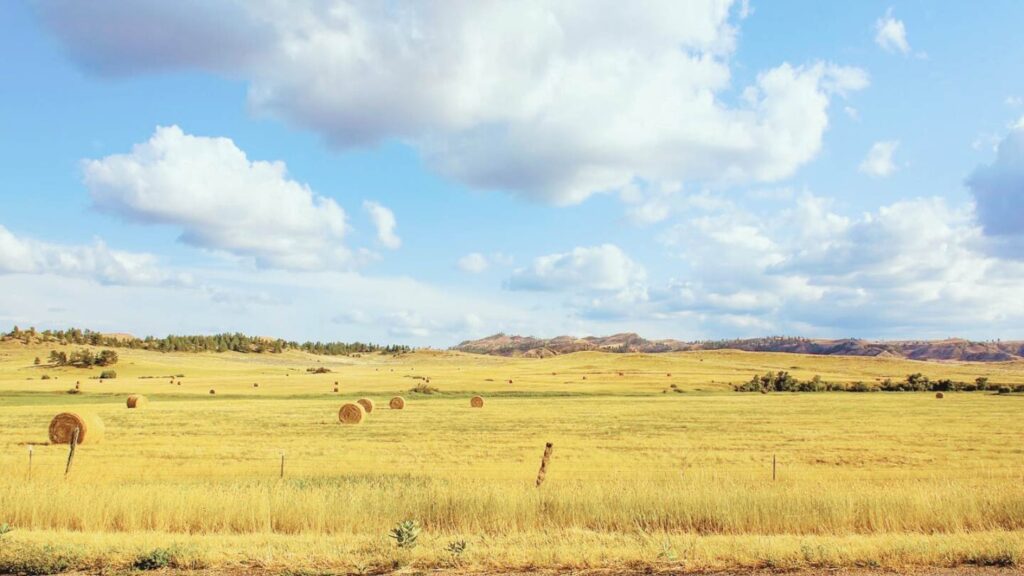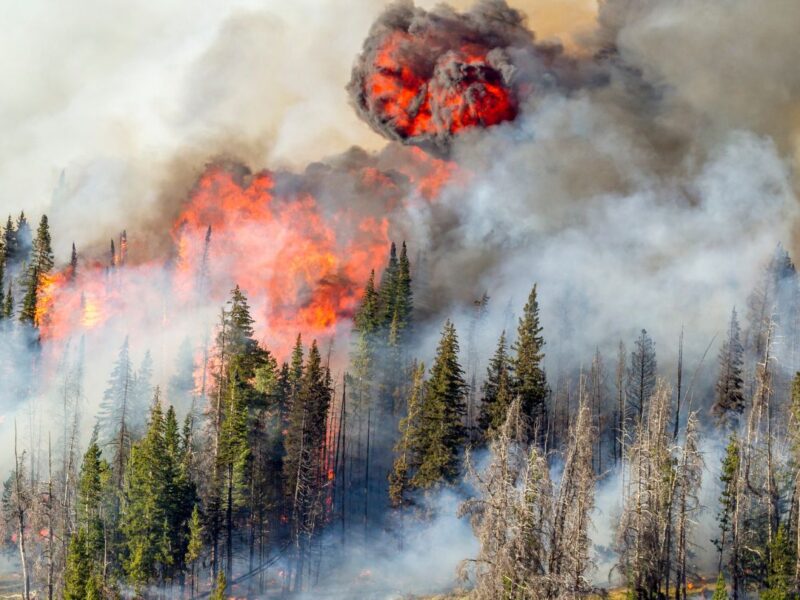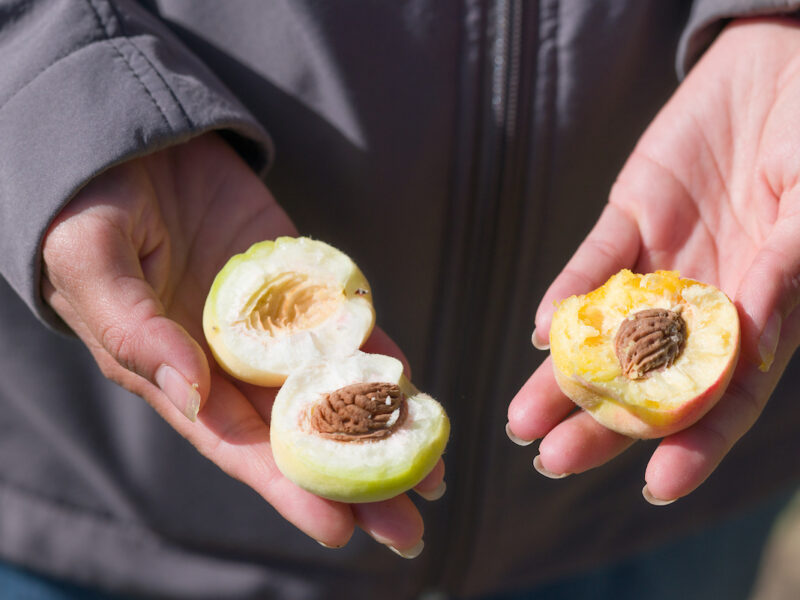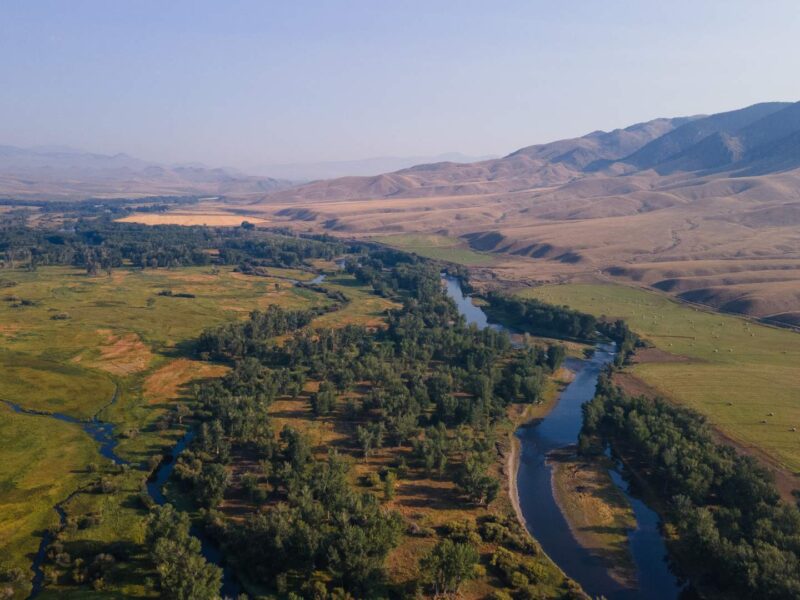Forage to Faucets – Denver Water’s sustainable watershed journey
GRAZING TOWARD MORE SUSTAINABLE WATERSHEDS
“Conservation is a state of harmony between men and land.”
– Aldo Leopold
Like many in the arid West, Denver Water customers turn on their faucets each day expecting clean and safe drinking water. Rarely is any thought given as to where it comes from and the natural systems that produce and preserve this precious resource.
Significant effort and capital are necessary to ensure water infrastructure is maintained and upgraded to meet Colorado’s growing demands of its expanding customer base. Denver Water expects to invest approximately $2.3 billion into its water collection, storage, treatment, and distribution system over the next 10 years to expand and secure a flexible, efficient system for its customers. While this infrastructure commitment is essential to the sustained delivery of quality water to households, Denver Water works at the opposite end of the supply chain as well.
Because of growing water scarcity in the American West and the Denver Metro area’s fast-growing population, Denver Water continues to evolve from its historical roots as a utility company charged with the sourcing and delivery of water, to expanding its mission to include the conservation and stewardship of all the natural resources which make up its watersheds and agricultural lands. Denver Water’s mission of conservation and sustainability has been, and will continue to be, impacted by climate change. In fact, climate change IS water change. Climate change is a direct threat to Denver Water’s watershed and agricultural lands, bringing increasing temperatures, catastrophic forest fires and reduced snowpack. Erosion, depleted soils, the absence of diverse animal and plant populations, lackluster runoffs or early runoffs are all signs of an unhealthy watershed suffering from climate change.
The natural resources within these watersheds are varied and diverse. They include arid rangelands, lush high-alpine meadows, foothill shrublands and sagebrush steppe. Coniferous forests of ponderosa pine, lodgepole pine and spruce, together with aspen populate the various woodlands of these watersheds. Elevation gradients across the properties range from 5,000 feet to 12,000 feet.
Included in Denver Water’s vast land collection is over 10,000 acres of grazing lands leased to local ranchers, ranging in size from 800 acres to 2,000 acres. Again, diverse ecosystems can be found across this range of grazing lands. Some are pure rangeland, some high-altitude grasslands and meadow. Many include sage shrubland or forests. A single grazing lease may include a mixture of ecologies comprising alpine meadows, mixed coniferous forests and both rich and semi-arid grassland.

Until recently Denver Water’s approach to managing these leases had been passive with the responsibility of land stewardship being left to the tenant-rancher. However, with its newfound priorities, Denver Water is taking a more proactive role in grazing management and in the care of the natural resources found in its watersheds.
In 2019 Denver Water began to partner with its tenant-ranchers to encourage improved grazing protocols and complete resource management. We began setting more demanding benchmarks aimed at improving soil and forage characteristics, as well as those of any wildlife and forest resources occupying the leased properties. The initiative operates from a holistic foundation. Symbolized in the mantra “Forage to Faucets”, it takes a macro-view of grazing and ranch management and recognizes it as playing a key role at the inception of water’s journey from soil and forage health to the customer’s faucet.
COUSINS WITH A COMMON PURPOSE
“The improvement of forest trees is the work of centuries. So much more the reason for beginning now.”
– George Perkins Marsh
The Forage to Faucets moniker is borrowed from another major conservation program at Denver Water, “Forests to Faucets.” Beside copying the clever rhythm, the words share a common meaning and purpose: To proactively manage natural resources within the watersheds in order to create sustainable ecosystems and secure, safe water sources. Forests to Faucets’ long-term work is the thinning of over-grown forestland, thereby reducing fuel loads and reducing the chances of future catastrophic fires. While Forest to Faucets’ priority is management of the timberland within Denver Water’s watersheds, Forage to Faucets’ primary focus is on the agricultural producer’s role in managing grazing, soil, and forage health. The emphasis on grazing management is foundational to a holistic, macro-management plan which includes management of all the natural resources within the leased land such as wetlands and riparian areas, wildlife and forests.
But grazing management can play a role in mitigating large forest fires as well, complementing the forest-thinning mitigation efforts by reducing lower canopy growth of shrubs and grasses. Thinning vegetation, sometimes in combination with cattle, bison or sheep grazing, is used to control trees, woody shrubs and invasive species, and keep grasslands and forests healthy. Following a low-intensity wildfire, grazing animals are attracted to the lush re-growth of grass. After an adequate recovery period, concentrated grazing can stimulate plant growth in these burned areas. In 2020, more than 10.3 million acres were affected by wildfires in the U.S. Grazing operations can play a role in decreasing large wildfires by increasing landscape resiliency, improving soil and grassland health, while creating fuel breaks that can slow fires down and decrease their intensity. Grazing of both public and private land can work hand-in-hand with other practices such as those initiated by the Forest to Faucets program, to improve and sustain landscapes while reducing available fuels for future fires.
Forests to Faucets was borne out of the 1996 Buffalo Creek and the 2002 Hayman wildfires that burned in Denver Water’s South Platte River watershed. Each historical in size, the two fires combined to scorch 150,000 acres. After the fires, heavy rains caused flash floods that engulfed the burn areas and washed debris from the barren soil into the rivers and reservoirs of the watershed. Denver Water spent more than $27 million to repair infrastructure, remove sediment and begin the restoration of lands around the rivers and reservoirs of Strontia Springs and Cheesman. Denver Water’s CEO Jim Lochhead reflected, “Those big fires taught us that investing in healthy forests is less expensive than dealing with the after-effects of a catastrophic wildfire.” In 2018, Denver Water and U.S. Forest Service added Colorado State Forest Service and the Natural Resources Conservation Service as new partners, and together committed to investing $33 million into this forest health and watershed protection program through 2021. In 2022, $30 million more was invested by the partners as large, destructive forest fires continue to plague the region.
Denver Water’s efforts with the Forage to Faucets initiative takes the principals of the forestry stewardship program and molds them into its own purpose of making monetary, physical, and operational investments that will improve and sustain the grazing properties within its watersheds. It is using the lessons of Forests to Faucets to be forward-thinking, expecting the investments in healthy soils and forage will be less expensive than the cost of remediation that would be needed to reverse damage done by poor ranching practices and depleted soils.
HAPPY COWS – HAPPY WATERSHED
“For the true measure of agriculture is not the sophistication of its equipment, the size of its income or even the statistics of its productivity …… but the health of the land.”
– Wendell Berry
We started with the question, can ranching and grazing management play a role in the protection and improvement of the watersheds in which they operate? The initiative’s operating principle is founded on the belief that water quality starts in the watershed and watershed health starts in the soil. Building resilience into a landscape is fundamental to its long-term survival. Soils and plants must be managed to withstand extreme and less predictable variations in climate. Overgrown forests, invasive species such as piñon, juniper, mesquite, and sagebrush overwhelm grasslands. Disappearing wetlands and degraded riparian areas, plus drought-stricken rangeland, present major challenges to today’s producers. Grazing strategies for meat production can be designed and managed to help protect biodiversity, enhance soils, and conserve water resources.
Land and water resource management is not a foreign principle to most western ranchers. In fact, for many it is the foundation of their management ethos. Today, more and more ranchers consider themselves “land managers” first, and “stock managers” second. The health of the landscape contributes directly to their bottom line with better animal health, higher fertility rates and profitable weight gain. Today’s ranchers must be able to apply a diverse set of skills including animal husbandry, rangeland management, knowledge of invasive weed control and ecology. In short, the definition of ranching is expanding to include management of the total ecosystem.
With its evolving Forage to Faucets program, Denver Water works with its tenant-ranchers to implement grazing and agricultural practices which emphasize soil health. Healthy soils hold more moisture, grow better forage, resist erosion, produce greater biodiversity and capture more carbon than depleted soils.
Carbon storage in the soil is being recognized as an important contributor to slowing down climate change. While carbon is one of the main building blocks for life, too much in the atmosphere has been identified as a major contributor to warming of the earth’s atmosphere. A direct relationship between increased levels of carbon dioxide in the atmosphere and rising global temperatures is gaining more acceptance. Soils contain approximately 75% of the carbon pool on land. Soils with high organic matter store or sequester carbon in decomposing plant and animal tissue. Carbon storage in soils occurs when grazing stimulates regrowth in grasses. When allowed to rest afterwards from grazing pressure and regrow, the grasses complete the carbon cycle in the plants which uses photosynthesis to convert carbon dioxide into plant material. In turn, plants remove carbon dioxide for the atmosphere and move the carbon into the soil where it is held in storage.

In addition, soils with adequate organic content (carbon) allow water to penetrate the soil surface quickly to prevent run off. They also have higher capacity to hold moisture at levels available to plant roots. Both are requirements for healthy vegetation and healthy soil. Modified grazing practices, which include planned grazing rotations and accurately calculated stocking rates that match forage levels, maintain rangeland health by not over-grazing or under-grazing pastures. Managed grazing practices allow plants time for regrowth and the time to build root mass capable of utilizing moisture and carbon stored in the soil. Rest also produces stronger leaf growth, the “solar panels” of plants which enhance forage production through photosynthesis. Proper grazing levels ensure control of noxious weeds and maintain productive amounts of plant litter that protects soils and slows evaporation of soil moisture.
These practices address the three foundational factors that define the relationship between soil, plants and grazing, and grazing’s impact on the health of soil and forage. These factors are: frequency of defoliation from grazing animals; intensity of defoliation; and the time allowed for rest and regrowth. Frequency is the number of times a plant is grazed during a defined period of time. Less frequency which allows for regrowth produces healthier plants. Intensity is the amount of plant removed. Moderate levels of grazing intensity aimed at leaving approximately 50% of plant material produce more high-quality leaf regrowth. Finally, and perhaps most importantly for determining the health, productivity and resilience of plants, is the rest cycle. The length of rest for regrowth is determined by temperature, available moisture, previous condition of forage and time of the year or season. Ultimately the animal’s response to grazing will be a reflection of the quantity and quality of available forage.
Well-managed grazing is climate-smart grazing. Following management practices which address the factors above leads to healthy soils. Well managed grazing also produces high animal performance and improved profits for the ranch manager. Grazing plans incorporate specified areas or allotments to be grazed, with time (duration of grazing on a particular area) and the number of animals (intensity) to be grazed on a particular area, to determine stocking rates and density (the number of animals on a defined area of land for a defined time). Together, these calculations produce a well-constructed grazing plan capable of maintaining productivity and health for both plants and animals. In turn, they produce and sustain healthy soils.
Forage to Faucet’s goal is to work with its tenant-ranchers to construct and manage grazing plans which promote high quality populations of grasses and plants capable of protecting soils and maintaining resilient landscapes. These same practices lead to healthy, productive animals and improved profits for the rancher.
MORE HEADS ARE BETTER THAN ONE
“Some folks don’t realize neighbor can be a verb.”
– Sid Goodloe
For centuries ranching and rural living have been synonymous with neighbors helping neighbors. Collaborating with the community which surrounds it, ranches have always depended on neighbors for spring branding, fall gathering or help with the hay harvest. The ranching community is built on neighbors coming together for a common goal. In this spirit of collaboration, I partnered with Colorado State University’s (CSU) School of Natural Resources and School of Agriculture to initiate the inaugural efforts of Forage to Faucets’ grazing management program on an 854-acre grazing lease along the Front Range of Colorado.
In the summer of 2020 professors, researchers, and students from the Natural Resource Ecology Laboratory (NREL), Forest and Rangeland Stewardship, Animal Sciences Department and Colorado State Extension came together to construct a plan of action for the property that would result in work to improve soil conservation, riparian stabilization, forage quality, native grass populations and grazing efficiency. In addition, the team was joined by multi-generational rancher Charles McKay, who has been a long-term tenant, renting the land from Denver Water for a 150-head commercial cattle grazing operation.
These rolling pastures, a few miles north of Golden, Colorado, are punctuated by intermittent and seasonal creeks which originate from several springs at the high points of the property’s western boundary. With a long ranching heritage, the land had been under private ownership until the mid-1950s when it was purchased by Denver Water. Referred to as “Leyden Gulch,” the property is part of Denver Water’s agricultural land inventory.
Leyden Gulch provides a living-laboratory for the Forage to Faucets program goals and provides a template for future efforts in other Denver Water grazing leases. Efforts started with an ecological assessment of current plant populations, wetland and riparian conditions, and wildlife populations, as well as areas of concern where erosion is damaging soils and having a negative impact on vegetation. The result was a strategic plan to initiate projects such as small hand-built dam construction in the waterways to hold back sediment and encourage riparian vegetation growth, as well as willow plantings which address erosion and riparian concerns by accelerating plant colonization. Studies show that tools such as these (collectively referred to as “natural infrastructure in dryland streams” or NIDS), can increase water availability, store carbon and nitrogen, reduce erosion, increase soil productivity and enhance biodiversity and temperature regulation, among other benefits.

Particular attention has been given to developing efficient water sources for cattle which also contribute to wetland health, bringing with it improved plant diversity and increased bird and wildlife populations. In addition, a grazing management plan is being developed with the tenant-rancher to provide improved rotations through smaller grazing units. More frequent rotations through these smaller units encourages rest and regrowth for these plant communities. This improves native grass and forb populations while reducing less-desirable grasses and noxious weeds.
A more recent addition to the partnership has been Jefferson County Open Space (JCOS), which owns 300 acres contiguous to Leyden Gulch. JCOS’s property has not been grazed for several years and is populated by many of the same native grass and plant species found on the Leyden Gulch property. This provides an excellent opportunity to introduce grazing into this property and monitor its long-term effect on the plant population’s diversity and health. A proposal is currently under consideration that would initiate a collaborative research project to measure the effects of grazing on the JCOS property.
In both the current Leyden Gulch project and the proposed JCOS project, continued monitoring plays a key role. Extensive testing and monitoring systems are being established to document forage conditions and species diversity.
A CALL TO ACTION
“Do unto those downstream as you would have those upstream do unto you.”
– Wendell Berry
Science and ecology must be put into practice through grazing management, wetland restoration, wildlife management and forestry. Water and soil conservation must be at the forefront of agriculture’s priorities. This requires neutralizing historical conflicts between ranchers and environmentalists, with collaboration taking its place. By seeking common ground in the effort to protect and restore western landscapes and preserving the heritage and financial viability of working ranches, we have been able to make great strides in both on Denver Water properties.
For centuries ranchers and farmers have stewarded the land and sustained rural communities with agricultural livelihoods. Water scarcity in the West has been one of the catalysts for advancement in conservation initiatives for improved ranching practices, production agriculture and soil management. Denver Water’s 10,000 acres is dwarfed by the nearly 33,000 farms and ranches which cover approximately 31.8 million acres in Colorado. These operations contribute more than $40 billion to the state’s economy each year. Ensuring the sustainability of agriculture in Colorado, and its contribution to the health of its rural communities, is paramount in the effort to maintain this economy and safeguard its western heritage.
Sorry, the comment form is closed at this time.






Evaline Woodrey
I was glad to finally see a reference to native plants in one article. I am a member of the Native Prairie Association of Texas and know that native plants are more nutritious than introduced varieties. Also they are essentially maintenance free.
James V. Long
Thanks for the feedback Evaline. Yes… it is an area that certainly deserves further attention/research. Hope to promote it more in our future efforts.
Michelle Heath
I am extremely proud of this work Denver Water is doing and enjoyed hearing the details in Jim Long’s I formative article. I dare anyone to read this article and not come away inspired!
James V. Long
Thank you Michelle for taking the time to read… and for the kind and encouraging response.